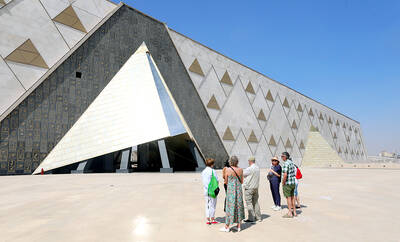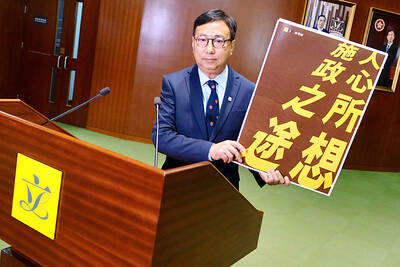The UN's attempt to get antiviral drugs to people with the AIDS virus fell far short of its goal of 3 million people by the end of last year, but it saved hundreds of thousands of lives nonetheless, the UN health agency said yesterday.
The total of treated people in low and middle-income countries has jumped to 1.3 million from the 400,000 people already on the drugs when the drive was declared two years earlier, an 84-page progress report issued by the World Health Organization (WHO) said.
Kevin De Cock, new AIDS director at the WHO, said the so-called "3 by 5 program" -- 3 million people on antiretroviral drugs by the end of last year -- helped lay the groundwork for the more ambitious goal of coming as close as possible to universal access to the medicine by 2010.
Much was learned from the difficulty of distributing the drugs in resource-poor countries and will help in the new goal -- set by the G8 last year, De Cock said.
"It is the aspiration that anybody with HIV should have access to treatment and care and prevention services should be delivered everywhere they're needed," he said. "It's a logical continuation of 3 by 5. There's no break."
De Cock, interviewed during his first day on the job on Monday, said he saw how difficult the challenge could be during his previous six years heading Kenya operations of the US Centers for Disease Control and Prevention.
In one area of Kenya the life expectancy is only 38 years, he said.
"What's been achieved is very impressive," De Cock said. "Obviously it is regrettable that the target of 3 million wasn't reached, and that does mean people have died and continue to die of what is a treatable disease."
Some 3 million people die of AIDS each year, he said. The WHO believes that the program averted between 250,000 and 350,000 deaths last year.
De Cock's predecessor Jim Yong Kim said last year that the development of systems and training of health workers would help the numbers of people treated to start increasing rapidly.
But De Cock said it was difficult to predict whether the world would be able to continue or improve on its current pace of adding 50,000 patients a month.
"It's very difficult to estimate the future," De Cock said. "The easy-to-treat populations are accessed quickly and first and it can actually get more difficult rather than more easy. But we hope that progress will continue at least at the current rate."
The report said that the world spent US$8.3 billion on AIDS last year, up from US$4.7 billion in 2003. Much of the funds came from the US government, the World Bank and the Global Fund to Fight AIDS, TB and Malaria.
Treatment in southern Africa, a focus of the program, has already risen sharply.
"Some countries have done extremely well, like Botswana. They've met their 3 by 5 target," De Cock said. "South Africa has actually scaled up pretty substantially. But they've all got to do better."
Nigeria is a large country that is starting to tackle the problem, he said.
It is easy to look only at Africa, but other regions are also of concern, De Cock said.
"There are some large countries such as India with a large number of infected people and treatment access is still very low," he said.
He said a general goal is to expand testing because most people who have AIDS don't know it.
Testing for children in particular needs to be more widespread so that infected youngsters can be identified quickly and started on treatment, he said. Health workers have to act quickly because about half of AIDS-infected children die before the age of two.
Prevention also must be restressed, De Cock said.
"With the emphasis on treatment, we have paid less attention to prevention," he said.
Even as the WHO was releasing its report, scientists in the US said they think they soon may have a pill that people could take to keep from getting the AIDS virus rather than just controlling the effects as antiretrovirals do.
Two drugs have shown such promise at preventing it in monkeys that officials said they would expand early tests in humans.

With much pomp and circumstance, Cairo is today to inaugurate the long-awaited Grand Egyptian Museum (GEM), widely presented as the crowning jewel on authorities’ efforts to overhaul the country’s vital tourism industry. With a panoramic view of the Giza pyramids plateau, the museum houses thousands of artifacts spanning more than 5,000 years of Egyptian antiquity at a whopping cost of more than US$1 billion. More than two decades in the making, the ultra-modern museum anticipates 5 million visitors annually, with never-before-seen relics on display. In the run-up to the grand opening, Egyptian media and official statements have hailed the “historic moment,” describing the

‘CHILD PORNOGRAPHY’: The doll on Shein’s Web site measure about 80cm in height, and it was holding a teddy bear in a photo published by a daily newspaper France’s anti-fraud unit on Saturday said it had reported Asian e-commerce giant Shein (希音) for selling what it described as “sex dolls with a childlike appearance.” The French Directorate General for Competition, Consumer Affairs and Fraud Control (DGCCRF) said in a statement that the “description and categorization” of the items on Shein’s Web site “make it difficult to doubt the child pornography nature of the content.” Shortly after the statement, Shein announced that the dolls in question had been withdrawn from its platform and that it had launched an internal inquiry. On its Web site, Le Parisien daily published a

China’s Shenzhou-20 crewed spacecraft has delayed its return mission to Earth after the vessel was possibly hit by tiny bits of space debris, the country’s human spaceflight agency said yesterday, an unusual situation that could disrupt the operation of the country’s space station Tiangong. An impact analysis and risk assessment are underway, the China Manned Space Agency (CMSA) said in a statement, without providing a new schedule for the return mission, which was originally set to land in northern China yesterday. The delay highlights the danger to space travel posed by increasing amounts of debris, such as discarded launch vehicles or vessel

RUBBER STAMP? The latest legislative session was the most productive in the number of bills passed, but critics attributed it to a lack of dissenting voices On their last day at work, Hong Kong’s lawmakers — the first batch chosen under Beijing’s mantra of “patriots administering Hong Kong” — posed for group pictures, celebrating a job well done after four years of opposition-free politics. However, despite their smiles, about one-third of the Legislative Council will not seek another term in next month’s election, with the self-described non-establishment figure Tik Chi-yuen (狄志遠) being among those bowing out. “It used to be that [the legislature] had the benefit of free expression... Now it is more uniform. There are multiple voices, but they are not diverse enough,” Tik said, comparing it